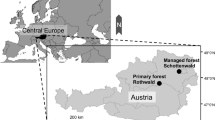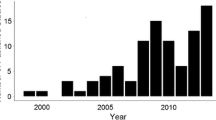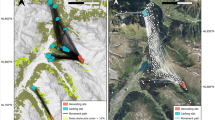Abstract
Myrmecochory (seed dispersal by ants) is an evolutionarily and ecologically common mutualism. Since the first study of the phenomenon, ecologists have sought to develop techniques to track ant-dispersed seeds. Often, thick leaf litter and the potential burial of seeds by ants make tracking of seeds difficult. Here we describe a seed-tracking technique for small seeds, which uses magnetic tags, developed for mark–recapture studies of fish, to track seeds after dispersal into the ant nest in temperate deciduous forests. We discuss our use of the technique as well as suggestions for improvement and other possible applications of the technique.


Similar content being viewed by others
References
Alverson WS, Díaz AG (1989) Measurement of the dispersal of large seeds and fruits with a magnetic locator. Biotropica 21(1):61–63
Bullock JM, Shea K, Skarpaas O (2006) Measuring plant dispersal: an introduction to field methods and experimental design. Plant Ecol 186(2):217–234. doi:10.1007/s11258-006-9124-5
Forget PM, Wenny D (2005) How to elucidate seed fate? A review of methods used to study seed removal and secondary seed dispersal. In: Forget PM, Lambert JE, Hulme PE, Vander Wall SB (eds) Seed fate: predation, dispersal and seedling establishment. CABI Publishing, Wallingford, pp 379–394
Gómez C, Espadaler X (1998) Myrmecochorous dispersal distances: a world survey. J Biogeogr 25(3):573–580. doi:0.1046/j.1365-2699.1998.2530573.x
Handel SN, Fisch SB, Schatz GE (1981) Ants disperse a majority of herbs in a mesic forest community in New York State. Bull Torrey Bot Club 108(4):430–437
Kalisz S, Hanzawa FM, Tonsor SJ, Thiede DA, Voigt S (1999) Ant-mediated seed dispersal alters pattern of relatedness in a population of Trillium grandiflorum. Ecology 80(8):2620–2634. doi:10.1890/0012-9658(1999)080[2620:AMSDAP]2.0.CO;2
Lengyel S, Gove AD, Latimer AM, Majer JD, Dunn RR (2009) Ants sow the seeds of global diversification in flowering plants. PLoS One 4(5):e5480. doi:10.1371/journal.pone.0005480
Ness JH, Morin DF, Giladi I (2009) Uncommon specialization in a mutualism between a temperate herbaceous plant guild and an ant: are Aphaenogaster ants keystone mutualists? Oikos 118(12):1793–1804. doi:10.1111/j.1600-0706.2009.17430.x
Zelikova TJ, Dunn RR, Sanders NJ (2008) Variation in seed dispersal along an elevational gradient in Great Smoky Mountains national park. Acta Oecol 34(2):155–162. doi:10.1016/j.actao.2008.05.002
Acknowledgments
We thank J. Rice for the suggestion to track seeds with coded wire tags and the use of his equipment. We thank K. Gross, R. R. Dunn and two anonymous reviewers for their reviews of the manuscript. Funding for this research was provided by NSF grant EF-0434298 and DEB-0842101 to K. Gross and a DOE NICCR grant to R. R. Dunn and DOE PER grant, DE-FG02-08ER64510 and NC State University.
Author information
Authors and Affiliations
Corresponding author
About this article
Cite this article
Canner, J.E., Spence, M. A new technique using metal tags to track small seeds over short distances. Ecol Res 26, 233–236 (2011). https://doi.org/10.1007/s11284-010-0761-8
Received:
Accepted:
Published:
Issue Date:
DOI: https://doi.org/10.1007/s11284-010-0761-8




